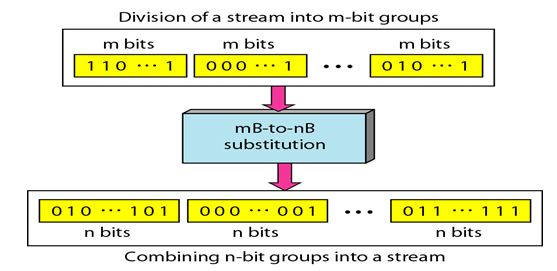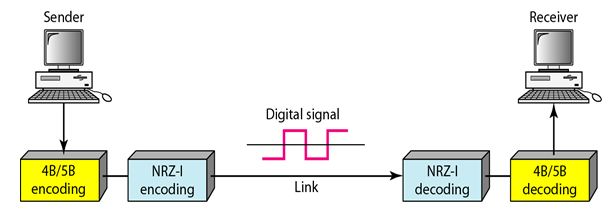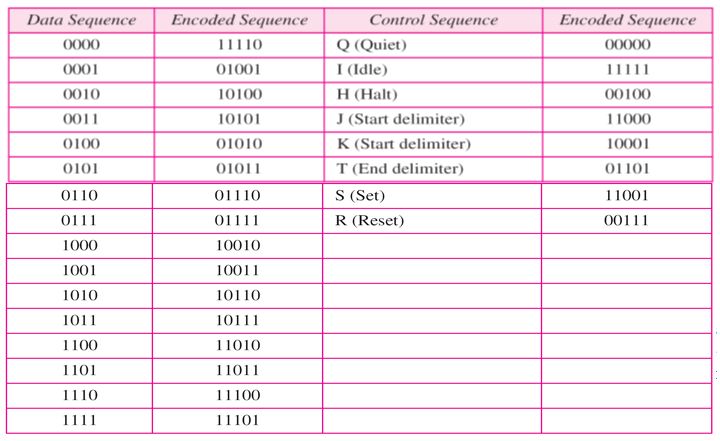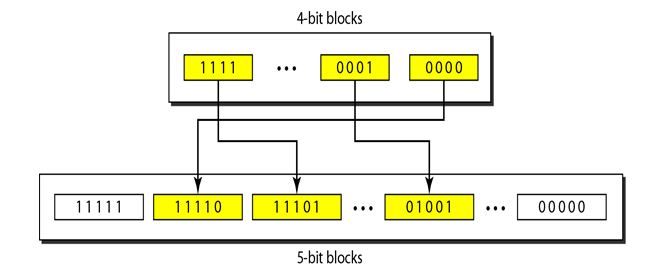Different Block Coding Techniques
We need redundancy to ensure synchronization and to provide some kind of inherent error detecting. Block coding can give us this redundancy and improve the performance of line coding.
Block coding changes a block of m bits into a block of n bits, where n is larger than m. Block coding is referred to as an mB/nB encoding technique.
Block coding normally involves three steps: division, substitution, and combination. In the division step, a sequence of bits is divided into groups of m bits.
For example, in 4B/5B encoding, the original bit sequence is divided into 4-bit groups. The heart of block coding is the substitution step. In this step, we substitute an m-bit group for an n-bit group.
For example, in 4B/5B encoding we substitute a 4-bit code for a 5-bit group. Finally, the n-bit groups are combined together to form a stream. The new stream has more bits than the original bits. The following figure shows the procedure.
1. 4B/5B Block Coding Technique:
The four binary/five binary (4B/5B) coding scheme was designed to be used in combination with NRZ-I. Recall that NRZ-I has a good signal rate, one-half that of the biphase, but it has a synchronization problem. A long sequence of ‘0’s can make the receiver clock lose synchronization. One solution is to change the bit stream, prior to encoding with NRZ-I, so that it does not have a long stream of ‘0’s.
The 4B/5B scheme achieves this goal. The block-coded stream does not have more than three consecutive ‘0’s. At the receiver, the NRZ-I encoded digital signal is first decoded into a stream of bits and then decoded to remove the redundancy. The following figure shows the idea.
In 4B/5B, the 5-bit output replaces the 4-bit input has no more than one leading zero (left bit) and no more than two trailing zeros (right bits). So when different groups are combined to make a new sequence, there are never more than three consecutive ‘0’s.
You May Also Like:
Line Coding and Its Characteristics
Different Line Coding Techniques
Different Scrambling Techniques
The following table shows the corresponding pairs used in 4B/5B encoding. Note that the first two columns pair a 4-bit group with a 5-bit group. A group of 4 bits can have only 16 different combinations while a group of 5 bits can have 32 different combinations. This means that there are 16 groups that are not used for 4B/5B encoding. Some of these unused groups are used for control purposes; the others are not used at all. The latter provide a kind of error detection. If a 5-bit group arrives that belongs to the unused portion of the table, the receiver knows that there is an error in the transmission.
The following figure shows an example of substitution in 4B/5B coding. 4B/5B encoding solves the problem of synchronization and overcomes one of the deficiencies of NRZ- I. However, we need to remember that it increases the signal rate of NRZ-1. The redundant bits add 20 percent more baud. Still, the result is less than the biphase scheme which has a signal rate of 2 times
that of NRZ-1. However, 4B/5B block encoding does not solve the DC component problem of NRZ-I. If a DC component is unacceptable, we need to use biphase or bipolar encoding.
2. 08B10B Block Coding Technique:
The eight binary/ten binary (8B10B) encoding is similar to 4B/5B encoding except that a group of 8 bits of data is now substituted by a lO-bit code. It provides greater error detection capability than 4B/5B. The 8BIlOB block coding is actually a combination of 5B/6B and 3B/4B encoding, as shown in the following figure.
The most five significant bits of a 10-bit block is fed into the 5B/6B encoder and the least 3 significant bits is fed into a 3B/4B encoder. The split is done to simplify the mapping table. To prevent a long run of consecutive Os or Is, the code uses a disparity controller which keeps track of excess Os over Is (or Is over Os).
If the bits in the current block create a disparity that contributes to the previous disparity (either direction), then each bit in the code is complemented (a 0 is changed to a 1 and a 1 is changed to a 0).
The coding has 210-28 =768 redundant groups that can be used for disparity checking and error detection. In general, the technique is superior to 4B/5B because of better built-in error-checking capability and better synchronization.
You May Also Like:
Analog to Digital Conversion Techniques
Different Transmission Modes
Back to DCN Questions and Answers






